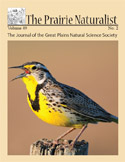Great Plains Natural Science Society

The Prairie Naturalist
Date of this Version
12-2011
Document Type
Article
Citation
The Prairie Naturalist 43(3/4): 119–120; December 2011
Abstract
The massasauga (Sistrurus catenatus) is a small rattlesnake that occurs from Texas to New York (Schmidt and Davis 1941, Conant and Collins 1991, Szymanski 1998). In Missouri, the Eastern massasauga rattlesnake (EMR; S. c. catenatus), a subspecies of the massasauga, occurs north and east of the Missouri River, is a former candidate for listing under the United States Endangered Species Act (Code of Federal Regulations 64 FR 57534; Szymanski 1998), and is listed as a state endangered species (Missouri Natural Heritage Program 2011). Missouri currently harbors five extant EMR populations (Johnson 2000, Durbian et al., unpublished report, J. Briggler, Missouri Department of Conservation, personal communication). The decline of this subspecies can be attributed to habitat loss and fragmentation, over utilization for commercial, recreational, scientific or educational purposes, predation due to habitat fragmentation, inadequacy of existing regulatory mechanisms, and indiscriminant or accidental killing (Szymanski 1988).
In Missouri, the EMR utilizes a combination of mesic and xeric bottomland prairie habitats and is typically associated with wetlands (Seigel 1986, Johnson et al. 2000). Over the past century, 87% of the wetland habitat has been lost in Missouri (Dahl 1990); however, current restoration efforts will enable EMRs to repatriate sites that are adjacent to existing populations. Repatriation of restored habitat has been documented for many other species groups including amphibians (Lehtinen and Galatowitsch 2001) and birds (Gardali et al. 2006), however, we were unable to find evidence in the literature involving snakes. Therefore, our objective was to document repatriation of restored habitat by EMRs on Squaw Creek National Wildlife Refuge (SCNWR) located in northwestern Missouri.
Included in
Biodiversity Commons, Botany Commons, Ecology and Evolutionary Biology Commons, Natural Resources and Conservation Commons, Systems Biology Commons, Weed Science Commons


Comments
Published by the Great Plains Natural Science Society, 2011. United States government work. Public domain material.